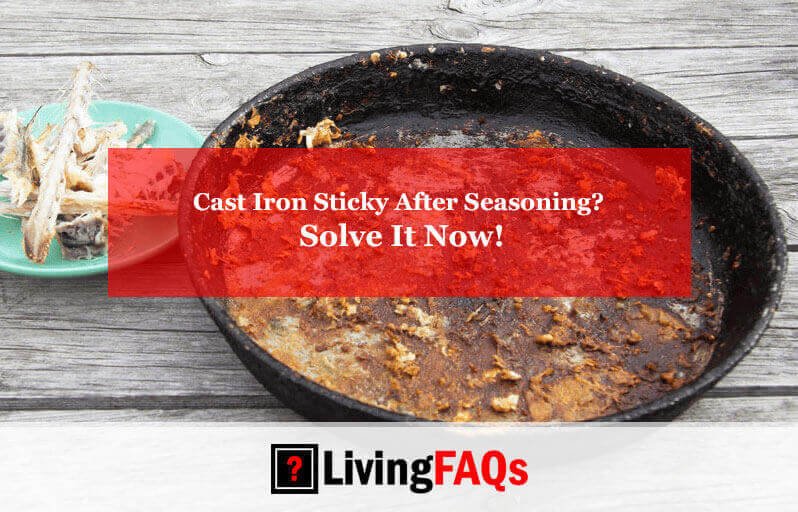Cast iron can become sticky after seasoning if the oil used is too thick or hasn’t fully polymerized. Ensuring a thin, even coating of oil and proper heat application prevents this issue.
Seasoning cast iron is a critical process that creates a non-stick surface and protects the cookware from rust. It involves coating the pan with a layer of oil and baking it to form a protective patina. Achieving the perfect seasoning can sometimes be a challenge, leading to a sticky residue on the pan’s surface.
This stickiness often results from excess oil that didn’t polymerize during the seasoning process. To avoid a tacky finish, it’s essential to apply a very thin layer of oil and heat the cast iron at the right temperature for a sufficient amount of time, allowing the oil to transform into a hard, slick surface. Proper seasoning ensures a durable and naturally non-stick surface, making your cast iron a favorite in the kitchen for everything from searing steaks to baking cornbread.

Credit: cooking.stackexchange.com
The Mystique Of Cast Iron Cookware
The mystique of cast iron cookware spans centuries. Its durability and versatility have made it a favorite in kitchens. Yet, sometimes a well-seasoned pan becomes sticky. This issue puzzles many home cooks.
Historical Significance
Cast iron cookware holds a special place in culinary history. Its use dates back to the Han Dynasty in China. Through the centuries, cast iron has been prized for its heat retention and longevity.
- Heirloom Quality: Passed down for generations.
- Historic Dishes: Key for traditional recipes.
- Survival Gear: Essential in early American kitchens.
Modern-day Appeal
In modern kitchens, cast iron’s appeal endures. Chefs and home cooks alike treasure it for both its performance and aesthetic.
| Quality | Benefit |
|---|---|
| Non-stick when seasoned | Easy to cook with |
| Even heating | Perfect cooking results |
| Indestructibility | Long-lasting investment |
Despite its many benefits, stickiness can occur after seasoning. This is often due to excess oil or incorrect seasoning methods. Proper care ensures a smooth and non-stick surface.
Common Seasoning Challenges
Many people face common seasoning challenges with cast iron cookware. Sometimes, even after seasoning, cast iron pans become sticky. This can be frustrating. Let’s dive into why this happens and how to fix it.
Myths And Misconceptions
Several myths exist about cast iron seasoning. Let’s clear them up:
- More oil means better seasoning – This is false. Too much oil can make the pan sticky.
- Seasoning lasts forever – Not true. Regular maintenance is needed.
- Soap ruins seasoning – Modern soaps are safe for cast iron.
Identifying Stickiness Causes
Several factors cause stickiness. Here are the main ones:
- Excess Oil – Using too much oil can leave a sticky residue.
- Low Heat – Not heating the pan enough won’t harden the oil.
- Food Residue – Bits of food left on the pan can cause stickiness.
To fix stickiness, clean the pan and reseason it. Use a thin layer of oil and heat it well.
Initial Seasoning Steps
Welcome to the essential guide on seasoning cast iron cookware. Proper initial seasoning steps ensure a non-stick, long-lasting surface. Let’s start with the basics to achieve that coveted, slick patina.
Cleaning Before Seasoning
Start with a clean slate for your cast iron. Remove any rust, residue, or factory oils. Follow these steps:
- Wash the skillet with warm, soapy water.
- Scrub using a non-metal brush or sponge.
- Rinse thoroughly under running water.
- Dry completely with a cloth or on the stove.
Choosing Your Seasoning Oil
Selecting the right oil is crucial for a non-stick surface. Consider these options:
| Oil Type | Smoke Point | Benefits |
|---|---|---|
| Flaxseed Oil | High | Durable coating |
| Canola Oil | Medium | Easy to find |
| Grapeseed Oil | High | Neutral flavor |
Apply a thin, even layer of your chosen oil to the cast iron. Use a lint-free cloth for this task. Ensure the entire surface, including the edges and handle, is coated.
The Seasoning Process Unveiled
Understanding the seasoning process is key to a non-stick cast iron surface. Let’s unveil the magic behind a well-seasoned cast iron skillet. We’ll break down the steps to ensure your cookware stays non-stick and lasts for generations.
Application Techniques
Applying the right oil is crucial for a good seasoning base. Use oils with high smoke points like flaxseed, canola, or vegetable oil. Here’s how to apply it:
- Clean the skillet thoroughly with soap and water.
- Dry it completely to prevent rust.
- Coat the skillet with a thin, even layer of oil.
- Use a paper towel to wipe off excess oil.
Baking The Seasoning In
After applying the oil, it’s time to bake it in. This step will create a durable layer. Follow these simple instructions:
- Preheat your oven to 375-400 degrees Fahrenheit.
- Place the skillet upside down on the top rack.
- Put aluminum foil on the bottom rack to catch drips.
- Bake for 1 hour.
- Let it cool in the oven.
Repeat the process for an even stronger seasoning. Now, your cast iron is ready for cooking!
Post-seasoning Stickiness Dilemma
The Post-Seasoning Stickiness Dilemma is a common issue. It happens after seasoning cast iron cookware. Sometimes, the surface turns sticky instead of smooth. This stickiness can ruin the non-stick surface. Let’s solve this sticky problem together.
When Good Seasoning Goes Bad
Good seasoning on cast iron should be smooth and non-stick. But, it can go bad. This happens if the oil isn’t heated enough. Or, if too much oil is used. A bad seasoning makes the surface sticky. This makes cooking and cleaning hard.
Sticky Culprits To Watch For
Several things cause stickiness after seasoning. Here are the main culprits:
- Excess Oil: Using too much oil leaves a sticky residue.
- Low Heat: Not heating the pan enough won’t harden the oil.
- Wrong Oil: Some oils are not good for seasoning.
- Uneven Layers: Uneven oil layers can cause stickiness.
To avoid stickiness, follow these tips:
- Use a thin layer of oil.
- Choose the right oil like flaxseed or canola.
- Heat the pan in the oven at 450-500°F for an hour.
- Let it cool in the oven.
Remember, fixing stickiness is easy. Remove the sticky layer. Then, re-season the pan. With care, your cast iron can last forever.
Troubleshooting The Stickiness
Are you dealing with a sticky cast iron skillet after seasoning? It’s a common issue, but don’t worry, there are solutions. Let’s troubleshoot the stickiness and get your cast iron back to its non-stick glory.
Adjusting Your Seasoning Technique
The right technique can make all the difference. Here’s how to adjust your approach for better results:
- Clean thoroughly: Remove old residue before seasoning.
- Oil choice matters: Use oils with a high smoke point.
- Thin layers win: Apply a very thin coat of oil.
- Heat it right: Ensure even heating in the oven.
- Time is key: Give it enough time to polymerize.
- Cool slowly: Let it cool in the oven gradually.
Re-seasoning Strategies
If adjusting your technique doesn’t solve the problem, it may be time to re-season. Follow these steps:
- Strip down: Remove existing seasoning with vinegar or oven cleaner.
- Wash it off: Scrub with soap and hot water, then dry completely.
- Season again: Apply a thin oil layer, heat, and let it cool.
- Repeat: Do this several times to build up layers.
Remember, patience is essential. A perfect non-stick surface takes time to develop.
Maintaining Your Cast Iron
Proper care keeps cast iron great for years. Even if it gets sticky after seasoning, don’t worry. This guide will make maintenance simple and effective. Cast iron cookware is tough, but it loves a gentle touch. Follow these tips and tricks to keep your skillet slick and non-stick.
Everyday Care Tips
- Clean while warm: Wipe out food bits after cooking.
- Use mild soap: It’s safe and can help with stickiness.
- Dry thoroughly: Water leads to rust, so avoid it.
- Oiling is key: A light coat of oil protects the surface.
- Store properly: Keep in a dry place with some airflow.
Avoiding Common Pitfalls
| Don’t Do | Instead |
|---|---|
| Soak in water: Rust can happen fast. | Clean quickly after use. |
| Scrub with metal: It can remove seasoning. | Use a soft brush or sponge. |
| Heat too fast: Cast iron likes it slow. | Warm it up on low heat. |
| Use cold food: This causes sticking. | Bring food to room temperature. |

Credit: m.youtube.com
Advanced Tips For Cast Iron Enthusiasts
Cast iron cookware lovers often face a common issue. Their pans become sticky after seasoning. This can be frustrating and confusing. But, with the right tips and tricks, you can overcome this challenge. Let’s dive into advanced techniques that will help you achieve the perfect non-stick surface.
Exploring Alternative Seasoning Oils
Choosing the right oil is crucial for seasoning. Not all oils work the same. Some provide better protection and a more durable non-stick surface. Let’s explore some alternative oils that seasoned cast iron users swear by.
- Flaxseed Oil: Creates a hard, durable surface.
- Grapeseed Oil: Has a high smoke point, perfect for seasoning.
- Avocado Oil: Also features a high smoke point and rich in healthy fats.
Experiment with these oils to find the one that works best for your cookware.
The Science Of Non-stick Surfaces
Understanding the science behind non-stick surfaces can help prevent stickiness. Seasoning creates a polymerized layer. This layer forms through a reaction between the oil and the iron at high temperatures. If the layer is uneven or too thick, stickiness can occur.
| Factor | Impact on Non-Stick Surface |
|---|---|
| Oil Type | Affects the polymerization process. |
| Heat Level | Ensures proper oil bonding. |
| Application Thickness | Thick layers can cause stickiness. |
To achieve the best non-stick surface, apply oil in thin, even layers. Allow the cookware to reach the right temperature. This will help the oil bond correctly with the iron.

Credit: www.reddit.com
Frequently Asked Questions
Why Is My Cast Iron Skillet Sticky?
The stickiness on cast iron is often due to excess oil that hasn’t fully polymerized during seasoning. A shorter, hotter bake can help.
How Do I Fix A Sticky Cast Iron Surface?
To fix a sticky surface, scrub the pan with salt and a paper towel, rinse, dry thoroughly, and re-season at a higher temperature.
Can Over-seasoning Make Cast Iron Sticky?
Yes, applying too much oil during the seasoning process can result in a sticky residue that hasn’t properly polymerized.
What Causes Stickiness After Seasoning Cast Iron?
Stickiness after seasoning is usually caused by incomplete polymerization of the oil, which can happen if the oil layer is too thick.
How To Prevent Cast Iron From Becoming Sticky?
Prevent stickiness by applying a very thin layer of oil and heating it past the smoke point so it fully polymerizes and forms a non-stick surface.
Conclusion
Restoring your cast iron to its non-stick glory is simpler than you might think. With the right seasoning process, sticky surfaces can be a thing of the past. Remember, patience and proper maintenance are key. Embrace these steps, and your cast iron cookware will reward you with superior performance for years to come.

